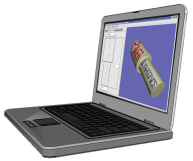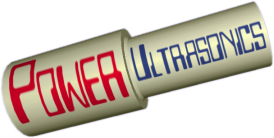A new online ultrasonics components store has just opened at www.UltrasonicsWorld.com. Check their amazing prices for replacement ultrasonics components, fully compatible with the major manufacturers' originals at a fraction of the cost.
You are here
Power calculation of ultrasonic generator
28 May, 2006 - 07:33 — Anonymous (not verified)
Hello Chris,
I have a doubt regarding the power calculation for an ultrasonic generator. Kindly clarify.
All ultrasonic generator manufacturers are telling the power in terms of watts. 1000W, 1500W, etc.Can you please tell how to calculate this power and what parameters are required for this? Generally for a rotating spindle in any machine, we calculate spindle power as (2*pi*N*T)/60 Watt, where N=spindle speed in RPM and T is torque in N-Meter. Like that is there any _expression for calculating the ultrasonic power?
My basic requirement is to calculate the power requirement for machining a ceramic material, whose properties area known viz. fracture toughness, etc.
Thank you in advance.
Regards
Kiran
Forums:


Re: Power calculation of ultrasonic generator
Hello saikiran,
Unfortunately the answer to your question is not very straightforward. Of course normal physical relationships apply - power is work done per unit time, work is force times distance travelled but in the case of ultrasonic systems force is very rarely constant and distance travelled may also be hard to evaluate. Even taking a probe system for which the vibration amplitude is known (eg. by measuring with a proximity sensor) the movement of the workpiece may be quite different because the probe loses contact with the workpiece for much of the cycle.
The other important point to bear in mind is that the quoted power of a system is typically a maximum rated value. For the type of application you mention, very few modern systems run at constant power; instead the amplitude is (approximately) constant and power varies according to the amount of load, up to the maximum rated value. You also need to look closely at the power rating since it may also be associated with a maximum permissable time or duty cycle.
So in deciding the power rating required for an ultrasonic machining operation I would take a pragmatic approach - start with a relatively low power generator (600 to 1000W) and a probe system with a scaled-down version of your process and test different conditions to establish what works best. Some variables to test would be amplitude, tip size, applied force, whether the tip is rotated and speed of rotation etc. Testing the process under different conditions should give you an appreciation of what works and by measuring the power required for the tests you will have a good basis for calculating how to scale up to the full production speed and size.
I guess that's not the answer you were hoping for but I just don't think it's possible to provide a simple formula to tell you how much power you will need. Of course if anyone can do so I'd be most happy to be contradicted!
You don't necessarily need to purchase equipment for such trials - a manufacturer or university may be willing to undertake test work for you to obtain these answers. In fact, I might even suggest you contact another member of this forum, bahman, who's having some success drilling ceramics with equipment he made himself (see [url=http://www.powerultrasonics.com/cgi-yabb/YaBB.pl?num=1145002794]this thread on ultrasonic drilling[/url]. Since then he's sent me some great photos and videos of the drill in action which I'll be putting up on this site shortly.
Although I realize I failed to answer your question I hope I've given you something more to think about.
Regards
Chris
Re: Power calculation of ultrasonic generator
Hi Chris,
Thank you for your prompt reply. I agree with your reply that there is no direct relation of power to amplitude and frequency. But In piezo.com site in FAQs section they just gave how much mechanical and electrical power we can extract from a given sheet. It must be experimentally obtained value.
I'm pasting the those answers here thinking that it may be useful for the readers of this thread.
One more doubt I've is: How the transverse movement of the piezo crystal is arrested or minimized in ultrasonic head. Any consequences?
I shall contact Bahman. But can you pls tell how to raise an alert or attract attention of Bahman (for that matter any other member in the forum) by just replying to this mail?
Here is stuff from piezo.com
How much mechanical power can I get out of one sheet?
In theory, one standard PSI-5A sheet (1.5" x 2.5" x .0075") used as an "extender" can do .00035 joules of work on the outside world in a quasi-static cycle (i.e. a slowly executed sinusoidal cycle). When operated just under its first longitudinal resonance of 15 KHz, the theoretically available output power from the sheet would be around 5 watts. In practice it is difficult to collect more than 10% of this work. Resonant designs can be considerably more efficient.
How much electrical power can I get out of one piezo sheet in principle?
Assuming that we stretch a PSI-5A (1.5" x 2.5" x .0075") sheet to ±500 microstrains quasistatically at a frequency just below its fundamental longitudinal resonance of 15 KHz, and that we collect 100% of the stored electrical energy at its height twice per cycle we would get approximately 9 watts of electrical power from the sheet. The mechanical energy input under these assumptions would be in excess of 100 watts. Resonant designs can be considerably more efficient.
However, the mechanical apparatus for achieving the above mentioned 15 KHz high strain excitation is not available, and there is no known electronic method for extracting 100% of the available energy.
Kiran
Re: Power calculation of ultrasonic generator
Hi Chris,
I noticed that in one of the threads in this forum, you've replied to a person designing a ultrasonic cleaning equipment that instead of his chosen 12V 70W generator, it would be better to start with 600 or 700 W. Can you tell how you arrived at such rough value? Is it due to experience or some calculation?
Regards
Kiran
Re: Power calculation of ultrasonic generator
[quote]But In piezo.com site in FAQs section they just gave how much mechanical and electrical power we can extract from a given sheet. It must be experimentally obtained value.[/quote]
Thanks for the info. To me that looks more like a theoretical value but in any case it's not the answer to the question I thought you were asking... Power ultrasonic transducers are capable of delivering typically between 1 and 3 kW at 20kHz, but even if, for example, a 3kW transducer is driven by a 3kW generator you still cannot know how much power will be delivered without defining the working conditions. The power required to drive the transducer and booster / sonotrode is quite low, perhaps 50W or less, and under no load that is how much power the generator will deliver. As the load increases, generator power increases to match.
[quote]One more doubt I've is: How the transverse movement of the piezo crystal is arrested or minimized in ultrasonic head. Any consequences?[/quote]
The piezo-ceramic disks are designed to expand and contract in the direction of the transducer axis. Sure there is also transverse movement, as with all elastic materials, but provided the diameter is small enough to avoid resonances in the radial direction it's not an issue (this is really the limiting factor on the maximum diameter of a transducer).
[quote]I shall contact Bahman. But can you pls tell how to raise an alert or attract attention of Bahman (for that matter any other member in the forum) by just replying to this mail?[/quote]
As a general rule to contact another member of a forum you can send a private message and he should find it on his next visit. In this case I will also be putting up some images he sent so the credit on that page may also give you an idea of where to find him!
[quote]I noticed that in one of the threads in this forum, you've replied to a person designing a ultrasonic cleaning equipment that instead of his chosen 12V 70W generator, it would be better to start with 600 or 700 W. Can you tell how you arrived at such rough value? Is it due to experience or some calculation?[/quote]
Are you referring to [url=http://www.powerultrasonics.com/cgi-yabb/YaBB.pl?num=1102730435]this thread[/url]? If so I think you misunderstood it - the existing system featured 12 transducers of 50W each (600 W total) and the aim was to replace all of them with a single transducer of 600W. If you meant a different thread please give me a link so I can remember what I was talking about!
Chris
Re: Power calculation of ultrasonic generator
Thank you Chris. The thread I was referring to is by Jurag. Your reply is as given below. Of course, it seems you have given that power value out of your experience.
I'd suggest the best equipment to start with would be a probe-type ultrasonic system with a high gain and a small tip. This will give you high amplitude on a small area and so a high energy density - ie. lots of energy concentrated into a very small volume of water. Typical "sonicator" type systems working at 20-30kHz, 500-1000W would be suitable.
Another thread where you could roughly predict the power suitability is :
Hi Shon,
Sorry but as a mere mechanical engineer my knowledge of the electronics is very limited. 600V for cleaning equipment sounds about right though (considerably higher for welding systems).
......
This question is just for clarification. However, I understood that there is no direct relation for power in terms of freq. and amplitude.
Thank you once again.
Regards
Kiran